Anatomy of an Era: George Sullivan, Part 2
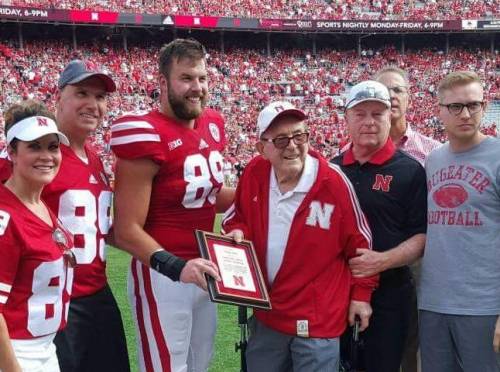
Excerpted from Chapter 42 of No Place Like Nebraska: Anatomy of an Era, Volume 1 by Paul Koch
George Sullivan
Athletic Trainer Emeritus
Q: Any fond recollections of the assistant coaches? Any unique personalities?
GS: I think it was strictly the togetherness and cohesiveness of the whole group there. They were so good to me that there’s not one of them I can’t say they weren’t nice.
There were times some charlatan would want to do something odd with them, like inserts in shoes, and padding and taping situations (there’s always somebody trying to get a coach to sign on with them or something), but they had enough respect to come see me if it was one of those things. In the treatment of a knee or fixing of an ankle? I’d just as soon listen to what some mothers had to say about getting a guy better than some of those guys. Jarvis Redwine’s mother, when he got hurt down in Missouri that time, she called me and told me how to treat the thing, and I thought, “Oh my gosh, how’s that possible?” But I did it anyway. I dipped that sack, dipped it in vinegar and did what she told me and wrapped that thing up, and I’ll be danged, he didn’t have any swelling the next day. (laughs) It’s a matter of listening at the right time and doing it then. (laughs)
Q: Anything in particular about the ’90’s teams stands out to you about that era, the personalities…
GS: That group is still real close today, that group of players. It was the closeness of the group as a whole.
And there again, the Florida State game… and I forget who was holding the ball for that last second field goal at the time… David Seizys! There should have been a penalty. They just smeared him. And the officials ran off the field like they didn’t see it. It should have been a defensive penalty…and so we should have won that Florida State Orange Bowl game. And Bobby Bowden was confronted on that and he wouldn’t talk about it. He was just like old Joe Paterno and that little square out of bounds in ’82. So Tom was really ruped a couple times there.
Q: I had a chance to talk to David Seizys and he does recall getting wiped out…
GS: That was bad, bad news. And Tom just kept right on coaching at that time; he was going right down the line and it didn’t faze him. He didn’t holler about it. Well, he didn’t have a chance… because they were off the field already, you know?
Q: George, could you run me through a typical day as the head trainer at the University of Nebraska? What were your days like?
GS: Usually I’d be down there for treatments at 7 o’clock in the morning so I could get ’em off to class. We’d treat all types of sports. What really kind of changed things, and what changed a lot of policy was when Title 9 came in and we had to let the girls in the training room over here, so consequently that changed the total situation. So we’d get them off to their classes and they’d come back early for another treatment.
During football season we’d start taping at 2 o’clock and tape ’til 3 o’clock, whenever they were going to have their meetings. They’d have their meetings up there in the football offices, and we’d go up to the field and watch them very closely with hydration and if anybody goes down, bring ’em back in at 5 o’clock and start treatment and hold the ones for Dr. Clare and his staff. They’d come down to see ’em and I’d always leave. Jerry was so good at staying on and seeing the final one with the doctors. I’d finally leave about 6:30 and he’d probably get out of there at 7 p.m. It was usually a twelve-hour day, and that was six days a week. And then Sunday mornings, we would have a little workout and see all the injuries from 10 to twelve noon.
Q: Nonstop, eh? Not just a job, it was a lifestyle?
GS: It was a lifestyle.
Last night on public television they had the great Big Bands of the fifties, my wife and I were sitting enjoying that. And I forget the name of this one song. My wife said, “That’s probably because you were still down to work!” I shouldn’t have brought that up. (laughs)
Q: You were in the vacuum known as the Nebraska Athletic Department, huh?
GS: It was a ring around the rosy.
And computers changed things a lot and you had to be more cognizant of record-keeping and so forth. It was hard to find time to write down all the John Does, but my time when the computers came around and it changed things, it was good. But by the same token, if it wouldn’t have helped out the athlete or young person later in life, we made sure we wouldn’t be treating stuff like that.
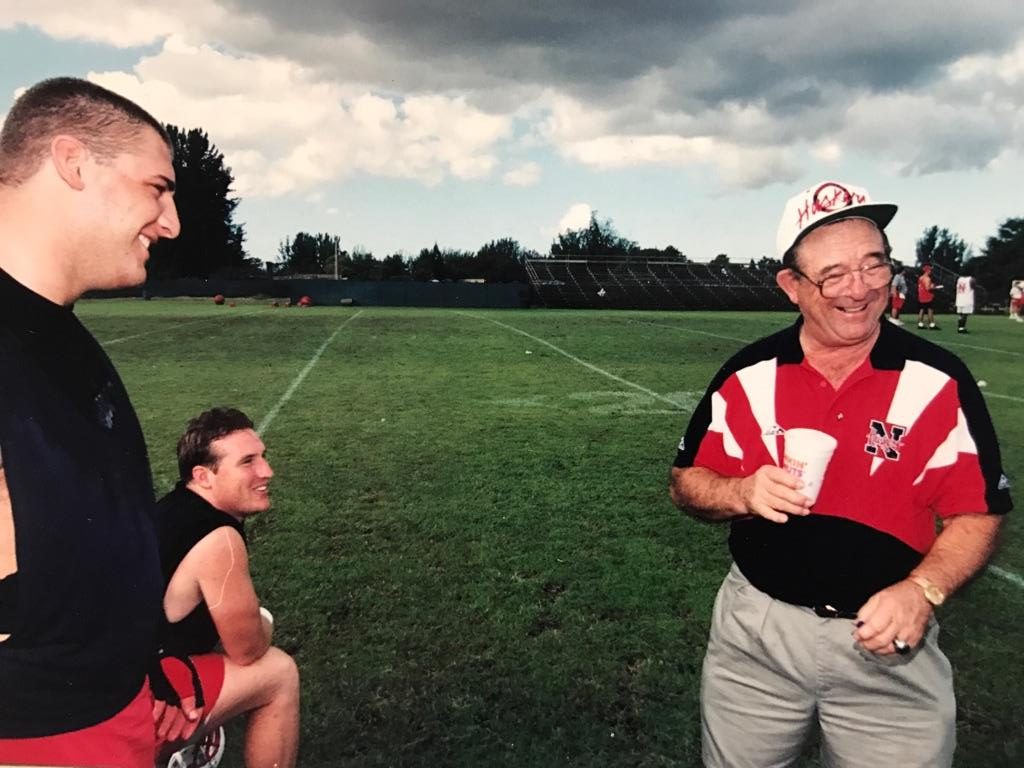
Christian Peter, Jason Pesterfield & George Sullivan share a chuckle (Joe Mixan photo)
Q: Speaking of the players of the ’90’s, do any of them stand out in particular for you?
GS: I suppose when Frost came back to us, because I knew his dad so well; Larry was one of my athletes. He was over at Malcolm and he lived right next to Paul Schnieder in those days, so when Frosty came back to us (he had some problems, a little different throwing motion, and we tried to straighten that out, but we went back to his original delivery because he was still pretty good with that), but I used to do a lot of shoulder treatments on that. I think he’ll do very well coaching. He’s been brought up with it all his life.
Q: Do you have a most memorable or favorite game as a trainer at Nebraska?
GS: I would still have to say the Game of the Century stood out the most. That was the most fascinating game. You knew we had those tear-away jerseys at that time, and all the changing of the jerseys. And the old McCook Flash, Jeff Kinney? My gosh, how many times we had to change jerseys on that guy!
Him and Johnny, it was something to behold. I thought we were going to run out of ’em, to the point that we were going to have to use plain practice jerseys. (laughs) We could sometimes go through five or six on those backs in a game. If they’d get torn so very much the official would tell us to get them changed, you know?
As far as tough injuries, Mickey Joseph at the Oklahoma game when he got his leg lacerated on the aluminum bench on their sideline, their trainer jumped right in and helped me out, he had pressure on that thing. I forget how many stitches he had to have. Many stitches. And right after that happened, his quarterback broke his leg out on that field. Both of us lost our quarterbacks in the first five minutes of that game.
Q: The athletic training community was pretty tight knit no matter what color of shirt you were wearing, eh?
GS: Yes. And as a matter of fact -in the old days, the minor sports?- when the track teams would come up I’d take care of their track teams for them when the coach was watching his budget. But the only time we’d be all together was when we were together for a football game.
Q: That would be very rare nowadays, huh?
GS: They’re like the assistant coaches now: they just hate one another. (laughs) That’s one thing about Charlie. Charlie McBride and Milt Tenopir, those guys were always with the other coaches. Consequently, how many clinics were they invited to talk at, you know? So the coaches, that used to not be.
Bob (Devaney)? That’s probably why he was asked to go everyplace around. He just liked everybody, even the Bear. That’s the way he was and that’s how Tom was, but we had coaches down through the years who wouldn’t do something like that, you know?
Q: What in particular stands out about the Game of the Century?
GS: Just that fact that we were always going back and forth. And kind of like Don Bryant said, he came down on the sideline and he said, “We’ve got to get this game over with, I’m gonna have a heart attack! I can’t stay up in the stands!” (laughs) There was just more action than you’d see in most games, and both sides were so determined to really win that game.
Q: If you ask me, that ‘94 Orange Bowl against Florida State holds a very close second place.
GS: I would say that, too. Very much so. And I guess the 1971 National Championship game, here we were standing there winning the National Championship, it was unbelievable. Unbelievable. You just go to the hotel and everybody was just so exuberant and so forth, I don’t know if anybody ever went to bed. You didn’t get back to the hotel until about 11:30 or midnight, but everybody just kept on going and singing. And I heard “Go Big Red” that night for so long, I never could get it out of my head, like a ringing in the ears.
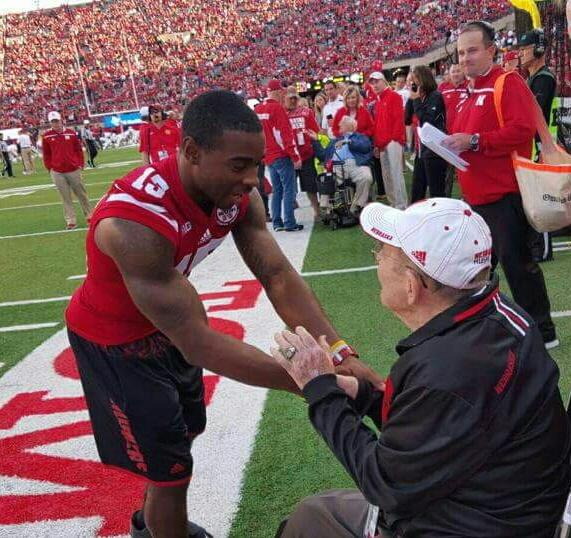
A sign of gratitude from DPE … (Unknown/Uncredited)
Q: Anything stand out to you about Coach Osborne’s last game, that Tennessee game?
GS: That was really unbelievable how those kids were playing their hearts out for him. Tennessee just couldn’t believe what was happening to them. Both sides of the line, those kids were just playing tremendous. You just never thought we could have prepared for that game that well.
Q: And what was your last game as a full-time trainer?
GS: Actually in ’94. The Miami game.
Q: What stands out about that game?
GS: I guess I wasn’t even thinking about it, that that was going to be it. (Because I was going to stay on and work until ’97.) Jerry had been doing so much with the management thing and building a new training room, I guess it didn’t even seem that anything major was really happening.
But I remember there against Miami, with Warren Sapp, he kept mouthing off at the time and I kept hollering at him. I shouldn’t have been doing it. (laughs) He was so funny in that he kept running back along the sideline after he’d make a good hit downfield. He said, “How’d you like that one, Doc?” I said, ‘That was out of bounds, you rat!’ (laughs) He just laughed. Later on I was down to Tampa one time and he says, “Weren’t you the Doc for Nebraska when we played?” I said, ‘I was. And you cheated!’ He laughed so hard. He was a great guy.
Q: So he remembered you by sight?
GS: He remembered me. Yes, he did. (laughs)
Q: Any memorable off-field occurrence for you?
GS: Oh golly, that is a good question. I guess there were so many, many, many good things in the Devaney and Osborne era, how could you put them all together? And they were all so good to the family. I had a good life is all I can say.
Q: Any memorable practices stand out to you?
GS: I guess, I kind of remember we bought a couple of new pieces of equipment that Corgan had them running through, and he had them diving over a cart, acting as if it was a goal line stand and the backs diving over the top. That was the time with Jeff Kinney and that bunch, he had them doing that: two of them came up in a row with their shoulders hurt a little bit. That was the only time I saw Bob really come out and get after his coaches. He said, “Let’s cut that dadgum drill out!” (laughs) That was a memorable time, because I could just see the look on all the coaches’ faces, because here’s Bob hollering at him, you know? It was a little too risky.
Q: Anybody behind the scenes who you feel had a huge part in those teams? Someone who most folks wouldn’t realize their contributions?
GS: I would really think way back to Sam Fuenning and what he did at the University of Nebraska for all those students; building the student health center for the students and the program for athletic medicine and all that. I thought they should have named the student health center after him. He started the School of Health, he was the first president of that. That’s never been recognized and it really surprised me. He did so much for the students: his innovations for cold remedies and the students coming in and getting checked out, the overall health of students. He and Kenny Rose developed a chair that we would do an electrocardiogram in the giving of physicals. When I heard my name was going on the training room, I thought, ‘Dang, and Sam didn’t even get his name on the student health center.’
Q: So what is it like to walk down into the training room with your name on it?
GS: Well, the students all run over and turn the light on so I can see it. (laughs) It’s real nice. I really don’t know the athletes anymore, being as I don’t work on them directly. But I can hear them talking in the background when I’m around there, and the kids say, “That’s him, the guy whose name is up on the wall.”
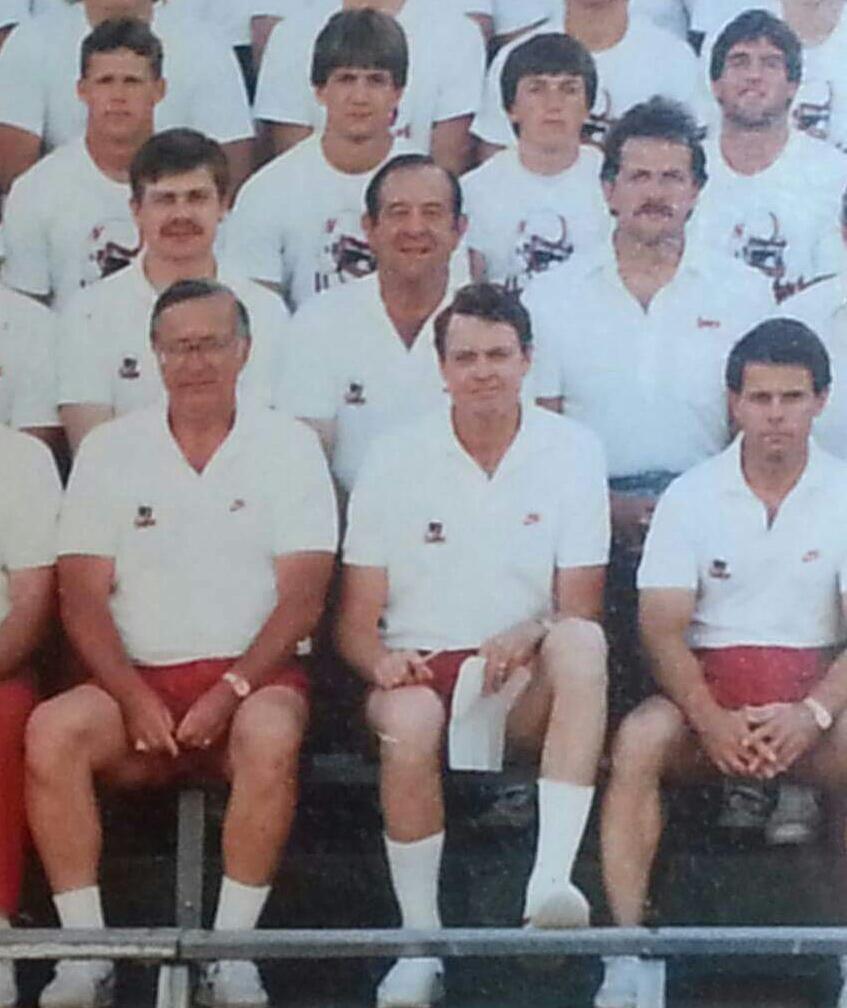 A surrounded Sully smiling for a summer football camp photo, circa 1985 (author as a high schooler, upper left) (Nebr. Sports Info)
A surrounded Sully smiling for a summer football camp photo, circa 1985 (author as a high schooler, upper left) (Nebr. Sports Info)
Q: I’m sure the guys have quite a few stories about Ol’ Sully, being that you’re an honored individual now. I recall my first few years on the staff there, where for some reason or other I‘d go over to Bill Sheppard’s shop area when ol’ Tom ‘Trainwreck’ Novak would be hanging out there with him. In retrospect, I wish I would have gotten to talk with Trainwreck a little more and gotten to know him better…
GS: Yeah, that’s another thing. Bill Sheppard, he deserves some recognition for all he did there and all the time he put in. He’d always show up down there at 5 o’clock in the morning and he’d go home and cook dinner at 3:30 (because his wife didn’t like to cook) and then he’d come back down and close up the place. But how many hours the guy put in down there! And if you needed a picture framed, why he’d build it. He did everything. Everything from the minor things to going out there and scooping the snow during the Kansas State game.
But the tough thing about Bill, which I hate most of all, was all those years with the blowers down in the stadium. After the games he’d make sure all that trash and stuff was finally pushed down the aisles and down below to be cleaned up, and all those years with those blowers he got to so he could hardly hear anymore, even if he was standing right in front of you. He’d read your lips, more or less. He was a fantastic young man. I remember when he first came on and the guy who he worked for -the name eludes me now- but Bill used to work out there on East Campus at the Ag College handling those big Holstein bulls as a fifteen year old, for crying out loud.
Q: He seemed like a farmer in the city, what with his tanned, weathered face and that red & white polka dotted cap he’d always wear. It was like his section of land was Memorial Stadium. Old Shep, working his ground…
GS: Around Thanksgiving he’d often cook up a whole meal for all the campus maintenance guys and they’d gather over there and sit and eat with him, too. (laughs)
Q: What was it like in South Stadium at that time with the Equipment guys right next door to you?
GS: We always worked so doggone close. If we had a new piece of equipment we’d go down and see them and show it to them. They had no qualms about buying a special shoulder pad, or if I could draw a design -something to protect the ribs or something- they knew exactly what equipment guy to call to make the thing, and we’d have it in there the next day. They just did a tremendous job.
Q: So you ended up fabricating a lot of your own stuff, huh?
GS: Oh yes, especially shoulder pads or rib pads, braces and stuff. There’s a couple things on the market a company named after me, for crying out loud, like the ‘Sully Shoulder Wrap.’ That was my design of taping. Doak Ostergard took it and talked the companies into putting my name on it. That, and the groin wrap and a hamstring wrap, that’s been a real popular thing. It’s been popular for rugby in Europe. I guess they don’t believe in surgery at all over there. (laughs) They use a ton of those shoulder wraps.
Q: Everybody’s got their own Sully, huh?
GS: Yep, everybody has their buddy named Sully. (laughs) But here we were doing that kind of thing in the early days. Like I said, Gatorade -really Huskerade- we did for the athletes, we just never did garnish all the goodies with those big contracts.
Fact of the matter, I was in the group that designed the first football shoes for Nike, too. Nike was just a track outfit, and Nike wanted us to use their football shoes they designed. And I didn’t like them: we were getting more sprained ankles. So they picked out a bunch of trainers from around the country and we all met in Massachusetts and that’s where they designed the things. That’s where we designed the very first football shoe for them that was worth something. It would have been the late ’70’s, early ’80’s.
Q: I remember those early ’80’s teams and those white Nike hightops for the turf. They were very popular.
GS: Yes, very popular. Then all of those outfits made a move to have them made in China, for crying out loud.
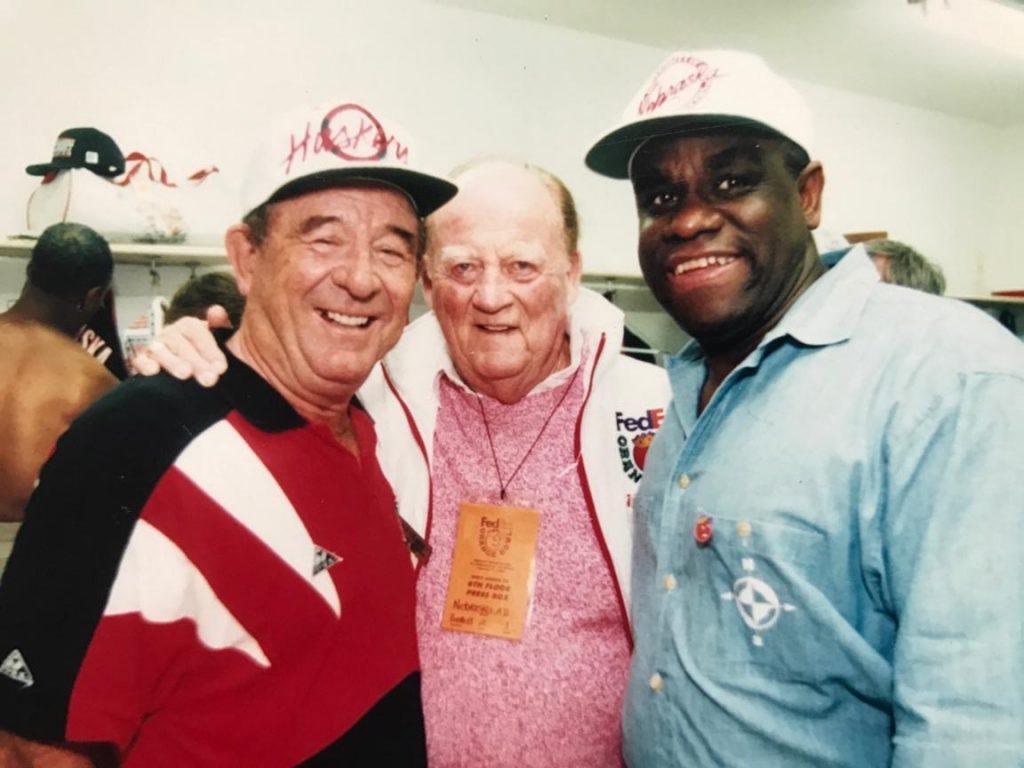
George Sullivan, Bob Devaney & Gene Huey (Joe Mixan photo)
Q: As a summary, George, your last few years in the ’90s there: any other lasting impressions or comments about the teams themselves worth noting?
GS: I think those early ’90’s with the Terry Connealys and all those guys, they stuck together to the Nth degree, and they were just fun to be around. (And they were kind enough to include me in a lot of things.) I guess (the neck slapping) there was one of the things I’m popular for, because they were a bunch who liked to wear caps all the time. (laughs) The togetherness of those teams was remarkable. There was not hatred or big squabblings, even from the lowest, meek guy to the biggest loudmouth. If they thought something was happening they settled it themselves. It was a togetherness that was really developed.
Q: That’s the difference between a group of football players and a team of football players…
GS: And there was not just one who was the sole leader. It was tough to pick a captain, because they were all captains.
Q: Amen, George. Amen. Thanks so much for your time.
GS: It was a delight. You take care.
End conversation.
What a trip. I just love ol’ Sully. It was never a dull moment with him in the room, especially with his oftentimes pointed commentary backed by years of experience. Wasn’t it Solomon who said “There’s nothing new under the sun”? Well, wise old George had the same worldview, as the guy practically invented modern day Athletic Training.
Do you want to know the most precious bit of info I gleaned from this conversation? It’s this: Out of all the teams Sully had known over a span of five decades, he mentioned the 60 & 3 era as having a most particularly strong bond: “They stuck together to the Nth degree… The togetherness of those teams was remarkable… It was a togetherness that was really developed.” Though it’s almost cliché, a true sense of ‘family’ existed, for we all know that you can pick your friends, but your family you’re stuck with, for good or ill. The fact that many incoming classes hardly knew each other until they arrived on campus, I guess the setup could have been described as resembling a family of siblings: each waiting to find who the new kid is, and then welcoming him with open arms to the dinner table, the dirt playground out back, brotherly advice and encouragement, you name it.
Notable quote #2:
George Sullivan remembering long-time Nebraska Groundskeeper Bill “Shep” Shepard: “He deserves some recognition for all he did there and all the time he put in. He’d always show up down there at 5 o’clock in the morning… how many hours the guy put in down there! … He did everything… He was a fantastic young man.”
Copyright @ 2013 Thermopylae Press. All Rights Reserved.
Photo Credits : Unknown Original Sources/Updates Welcomed
Paul Koch